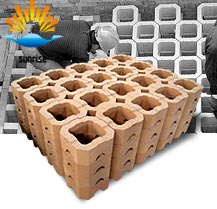Introduction of Lightweight High Aluminum Brick and Application of Refractory Brick
2017-06-19
High aluminum tiles, also known as high-aluminum heat insulation brick (high-aluminium heat insulation brick). Alumina content of more than 48%, mainly by the mullite and glass phase or corundum together composed of light refractories. Bulk density of 0.4 ~ 1.35g / cm3. Porosity 66% to 73%, compressive strength of 1 ~ 8MPa. Thermal shock resistance is better.
Usually using high bauxite clinker plus a small amount of clay, after grinding with gas or foam method of casting in the form of mud, forming, by 1300 ~ 1500 ℃ firing. Sometimes with industrial alumina instead of part of the bauxite clinker. Used for masonry lining and insulation layer, and no strong high temperature melting materials erosion and erosion of the site. Direct contact with the flame, the surface contact temperature shall not be higher than 1350 ℃.
Refractory material is the main building materials of industrial furnaces. It is the basic material for the development of iron and steel, nonferrous metals, building materials, petrochemical, machinery and electric power. Refractory materials in the metallurgical industry occupies an important position, China's metallurgical industry consumes about refractory materials, which in turn smelting furnace, heating furnace and ancillary equipment consumption of the largest proportion of refractory materials. Such as masonry blast furnace, need to consume clay brick, high alumina brick, magnesia brick and corundum brick about tons. Masonry of the copper reflow furnace, the need for magnesia brick, magnesia chrome brick, high alumina brick, clay brick and a variety of lightweight insulation materials, about more than tons. The use of refractories is not only related to the smooth progress of the production process, but also in the production costs occupy a certain proportion. At present, China's refractory consumption is very large, with the total annual output of refractories compared with the total annual output of steel (steel, up to tons of steel, higher than the advanced industrial countries more than doubled. Consumption of a variety of refractories .. smelting a ton of coarse copper also need to consume high quality refractories.Therefore, from the technical point of view, or economic point of view, the correct choice and rational use of refractories, are of great significance.With the industrial furnace Kiln large-scale, high efficiency and automation, furnace operating conditions become increasingly harsh, the production and use of refractory materials put forward higher requirements. Energy consumption increased rapidly, increasingly contradictory supply and demand, industrial furnace energy saving has become important for the development of production One of the key links.
Refractories must also meet the needs of energy conservation. Therefore, according to the structural characteristics of the furnace and thermal system and production process conditions, the correct choice and rational use of the corresponding refractories, research and development of new high-quality refractory materials to further ensure the efficient operation of high-temperature furnace to improve the life of the furnace , Reduce refractory consumption and energy saving. It has been described that refractories are likely to withstand the erosion and erosion of calcined slag and metal and high temperature and high dust corrosive furnaces at high temperatures for long periods of time. They are subjected to sudden changes in temperature and the combined effects of various stresses. The impact and wear. Today, no refractory material can fully meet the requirements of the above conditions of use. Although some refractory varieties of excellent performance, but the price is expensive, not yet in the furnace a lot of applications. This requires careful analysis of the working conditions of various industrial furnaces, the study of refractory material damage mechanism, so that targeted to the specific furnace, the specific needs of specific parts, selection and application of materials with the corresponding materials, and pay attention The various parts of the refractory between the life of the coordination and coordination.
First, the metallurgical kiln on the requirements of refractory metallurgical kiln variety, the structure is also very complex, the choice of refractories and applications are often very different. However, it must meet the following requirements: to withstand the role of high temperature, not softening, no melting; can withstand high temperature load, without loss of structural strength, no deformation and collapse; good volume stability, high temperature does not occur too much Of the volume expansion and contraction, re-burning line changes in small; able to resist the rapid changes in temperature; to resist the high temperature melt chemical erosion and physical scouring; shape size, small tolerance.
Second, the refractory in the mission of the mechanism of damage: metallurgical kiln long-term continuous operation at high temperatures, refractory working conditions are poor, easily damaged, of which the most typical melting furnace. There are many factors that cause the damage of refractory materials, but the following are the main points: slag corrosion due to slag and metal or dust corrosive gas caused by the physical and chemical effects of erosion. According to statistics, the lining of colored metallurgical furnaces is damaged by the erosion of slag. Steel converter and electric slag line area is mainly due to slag erosion, and become the most serious damage to the site, and determines the life of the lining.

